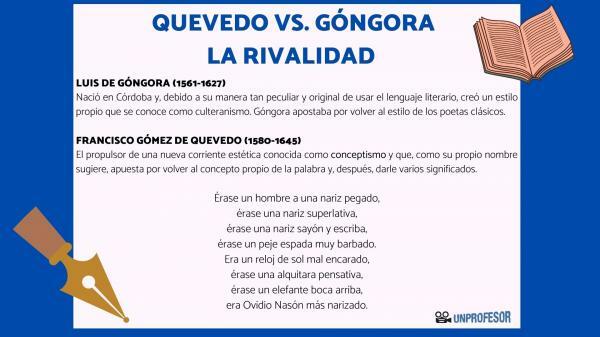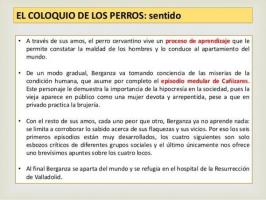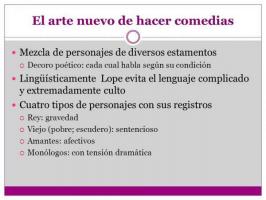QUEVEDO and GÓNGORA rivalry and their differences

One of the great rivalries that exist in the world of Spanish literature is the one starring Quevedo and Góngora, two writers from Golden age who had a big dispute at the time. The two authors lived in the famous Las Letras neighborhood of Madrid, so they knew each other a lot and the encounters (and disagreements) were quite frequent. They both cultivated a very satirical literature and this was the medium they used to further fan the flame of conflict and today we have very visible traces of the existing enmity.
In this lesson from a TEACHER we are going to talk about Quevedo and Góngora, their differences and their rivalry so studied in the history of Spanish literature. A rivalry that arose as a literary duel and that has its origin in 1601 in the city of Valladolid. Here we tell you everything!
Index
- Introduction to Quevedo and Góngora
- Start of the rivalry between Góngora and Quevedo
- The dispute between Quevedo and Góngora
- Góngora and Quevedo: most important differences
- Quevedo and Góngora: the nose poem
Introduction to Quevedo and Góngora.
Before starting to talk about the enmity between Quevedo and Góngora, we are going to contextualize both writers to get to know them better.
Luis de Góngora (1561-1627)
GongoraIt's one of the authors of the Golden Age most outstanding and studied. He was born in Córdoba and, due to his peculiar and original way of using literary language, he created his own style known as culteranismo. Góngora was betting on returning to the style of the classical poets and employing some rhetorical figures like hyperbaton, as well as cultured words. The result of his style were poems that were complex to understand and full of an unusual vocabulary.
Francisco Gómez de Quevedo (1580-1645)
On the other hand we have Quevedo, an author almost 20 years younger than Góngora and who represents the other side of the coin. This author from Madrid is the promoter of a new aesthetic trend known as conceptism and that, as his own name suggests, he is committed to returning to the proper concept of the word and, later, giving it various meanings. An author who is committed to polysemy and who has a style that is easier to understand.
Start of the rivalry between Góngora and Quevedo.
We have indicated that Quevedo and Góngora lived in the same Madrid neighborhood: Las Letras. However, this is not where they met, but rather where they did. in Valladolid. Quevedo arrived first and two years later Góngora arrived; The two of them moved to this city to become patrons of the Court and, thus, to be able to improve their literary reputation.
It was here that the dispute between the two authors began. It all started with a poem written by Quevedo that was directly titled "Against Don Luis de Góngora." The verses are as follows:
This Cyclops, not Sicilian,
of the microcosm yes, last orb;
this antipode face, whose hemisphere
zone divided into Italian term;
this circle alive in every plane;
this that, being only zero,
he multiplies and part by whole
every good Venetian abbot;
the miniature yes, but blind vult;
the bearded chink of manes;
this peak of vice and insult;
this one, in whom today farts are mermaids,
This is the ass, in Góngora and in worship,
that a bujarrón hardly knew him.
This was the poem that started with the rivalry between Góngora and Quevedo, the starting point, a whole declaration of intent that the young author carried out. But Góngora was not far behind and responded with these verses:
Muse that blows and does not inspire
and he knows that he is the traitor
put your fingers better
in my bag than in his lyre,
It is not from Apollo, which is a lie ...
Góngora was not far behind with his insults and, in addition to treating Quevedo as an ignorant, he also baptized him with the name of "Francisco de Quebebo", as it is believed that this author was a regular in Castilian taverns.
Quevedo was not far behind: he said that Góngora was a card player, homosexual and the worst insult that could be said in Spain at that time: Jewish.

The dispute between Quevedo and Góngora.
Let us remember that the conflict between the two arose as a literary duel, that is, satirical poems were sent in which they messed with each other. The most famous and well-known of all is that of "To a man with a big nose" by Quevedo and that he directly rebuked Góngora highlighting his prominent nose.
The rivalry began in the city of Valladolid, the city where the Court was located in 1601. The writers moved to this city and, to stand out in the sector, they attacked each other. At that time, Góngora was already a reputed and respected writer, however, Quevedo had only appeared in the sector for a year. This was the main reason why Quevedo began attacking a great figure like Góngora: he wanted to be noticed.
Francisco de Quevedo dared to interfere with Góngora and the verse "Once upon a man stuck to a nose ..." it has become one of the best known in our literary history. But Góngora was not far behind: upon receiving the taunts and insults from Quevedo, he began to accuse him of trying to make translations of texts written in Greek without having any idea of this language.
Quevedo and Góngora were great enemies and their relationship is fully visible in the many poems that were "dedicated" to each other. Verses loaded with insults and derogatory metaphors that are still another reflection of the relationship they had with each other.
Why were Góngora and Quevedo enemies?
But what is the real cause of the enmity between Quevedo and Góngora? We have already said that, at the time, it was common for some literati to mess with others to try to discredit them and make a name for themselves in the sector. But that was not all. In the case of Quevedo and Góngora, there are other reasons that made them not sympathetic.
Above all we have to bear in mind that the two writers came from different aesthetics: the conceptist, defended by Quevedo, and the culterana defended by Góngora (and, in fact, Góngora is considered to be the father of this aesthetic). Both aesthetics were very common in the Spanish seventeenth century, however, they clashed a lot with each other, so the purposes and techniques that were followed were disparate.
Quevedo's use of lexical cultisms that Góngora used in works such as The Solitudes, as well as the use of neologisms (invented words) that sought to reflect the poet's own world.

Góngora and Quevedo: most important differences.
We are now going to talk about the differences between Quevedo and Góngora and, thus, we will understand more about the reasons for the conflict that existed between both authors.
- Góngora was a culteranista, an aesthetic current that prioritized the form and complexity of writing. He sought to play with words to emphasize his emotion and his concept; in addition, it recovered classical forms to give a more cultured touch to his writings. It employs a very cultured and elevated language full of metaphors, neologisms, hyperbole, etc.
- Quevedo was a conceptist, a type of aesthetics that gives more importance to the content, to the concept, than to the form. A tradition that sought to associate ideas and words in an original way.
Quevedo and Góngora: the poem of the nose.
To finish this lesson on the rivalry between Quevedo and Góngora, we are going to leave the famous poem of "To a nose" which has become one of the best known in literary history. A nose that, furthermore, for Quevedo was another sign that Góngora was Jewish, the fiercest insult of the time.
Once upon a man stuck a nose,
once upon a superlative nose,
once upon a time there was a sayón nose and write,
Once upon a very bearded swordfish.
It was a badly faced sundial,
once upon a pensive altar,
once upon a time there was an elephant face up,
Ovidio Nasón was more narrated.
Once upon a spur of a galley,
once upon a pyramid in Egypt,
the twelve Tribes of noses was.
Once upon a very infinite nose,
a lot of nose, nose so fierce
that in the face of Annas it was a crime
But, as we have indicated previously, Góngora never stood idly by and also responded with a satirical and humorous poem. Here we leave you "De Quevedo", a burlesque text written by Góngora:
Your coplones, cordovan sound,
satire of my garments and offal,
in various bundles and bundles
my servers have shown them to me.
They must be good, because they have passed
for so many hands and for so many eyes,
although he admires me a lot in my anger
of what dirty thing I have cleaned.
I did not take them, because I was afraid to cut myself
for the dirty, much more than for the sharp,
I didn't even want to read them, so as not to get dirty.
Thus, I am no longer scared to see that he could
enter my cairns to disturb me
a paper, cleaning so bare.
These are just some examples of the rivalry between Quevedo and Góngora, however, there are many more sonnets that testify to this relationship!
If you want to read more articles similar to Quevedo and Góngora: differences and rivalry, we recommend that you enter our category of History of Literature.
Bibliography
- De Paz, A. (1999). Góngora... and Quevedo? Criticón, 75, 29.
- Count Parrado, P. P., & García Rodríguez, J. (2005). Between voices and echoes: Quevedo against Góngora (once again). Golden Age, (24), 107-144.
- Celma Valero, M. D. P. (1982). Baroque Invectives: Góngora and Quevedo. Studia Philologica Salmanticensia, (6), 33-66.
- Arellano-Ayuso, I. (1984). A sonnet from Quevedo to Góngora and some satirical neologisms.



